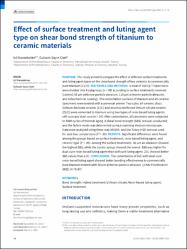| dc.contributor.author | Karaokutan, Işıl | |
| dc.contributor.author | Sayın Özel, Gülsüm | |
| dc.date.accessioned | 2022-05-27T11:28:53Z | |
| dc.date.available | 2022-05-27T11:28:53Z | |
| dc.date.issued | 2022 | en_US |
| dc.identifier.citation | Karaokutan, I. ve Sayın Özel, G. (2022). Effect of surface treatment and luting agent type on shear bond strength of titanium to ceramic materials. Journal of Advanced Prosthodontics, 14(3), 78-87. https://doi.org/10.4047/jap.2022.14.2.78 | en_US |
| dc.identifier.issn | 2005-7806 | |
| dc.identifier.uri | https://doi.org/10.4047/jap.2022.14.2.78 | |
| dc.identifier.uri | https://hdl.handle.net/20.500.12511/9477 | |
| dc.description.abstract | PURPOSE. This study aimed to compare the efect of diferent surface treatments and luting agent types on the shear bond strength of two ceramics to commercially pure titanium (Cp Ti). MATERIALS AND METHODS. A total of 160 Cp Ti specimens were divided into 4 subgroups (n = 40) according to surface treatments received (control, 50 μm airborne-particle abrasion, 110 μm airborne-particle abrasion, and tribochemical coating). The cementation surfaces of titanium and all-ceramic specimens were treated with a universal primer. Two cubic all-ceramic discs (lithium disilicate ceramic (LDC) and zirconia-reinforced lithium silicate ceramic (ZLC)) were cemented to titanium using two types of resin-based luting agents: self-cure and dual-cure (n = 10). After cementation, all specimens were subjected to 5000 cycles of thermal aging. A shear bond strength (SBS) test was conducted, and the failure mode was determined using a scanning electron microscope. Data were analyzed using three-way ANOVA, and the Tukey-HSD test was used for post hoc comparisons P(<.05). RESULTS. Signifcant diferences were found among the groups based on surface treatment, resin-based luting agent, and ceramic type P(<.05). Among the surface treatments, 50 μm air-abrasion showed the highest SBS, while the control group showed the lowest. SBS was higher for dual-cure resin-based luting agent than self-cure luting agent. ZLC showed better SBS values than LDC. CONCLUSION. The cementation of ZLC with dual-cure resin-based luting agent showed better bonding efectiveness to commercially pure titanium treated with 50 μm airborne-particle abrasion. | en_US |
| dc.language.iso | eng | en_US |
| dc.publisher | Korean Academy of Prosthodontic | en_US |
| dc.rights | info:eu-repo/semantics/openAccess | en_US |
| dc.rights | Attribution-NonCommercial 4.0 International | * |
| dc.rights.uri | https://creativecommons.org/licenses/by-nc/4.0/ | * |
| dc.subject | Bond Strength | en_US |
| dc.subject | Hybrid Abutment | en_US |
| dc.subject | Lithium Silicate | en_US |
| dc.subject | Resin-Based Luting Agent | en_US |
| dc.subject | Surface Treatment | en_US |
| dc.title | Effect of surface treatment and luting agent type on shear bond strength of titanium to ceramic materials | en_US |
| dc.type | article | en_US |
| dc.relation.ispartof | Journal of Advanced Prosthodontics | en_US |
| dc.department | İstanbul Medipol Üniversitesi, Diş Hekimliği Fakültesi, Protetik Diş Tedavisi Ana Bilim Dalı | en_US |
| dc.authorid | 0000-0001-8833-5259 | en_US |
| dc.identifier.volume | 14 | en_US |
| dc.identifier.issue | 3 | en_US |
| dc.identifier.startpage | 78 | en_US |
| dc.identifier.endpage | 87 | en_US |
| dc.relation.publicationcategory | Makale - Uluslararası Hakemli Dergi - Kurum Öğretim Elemanı | en_US |
| dc.identifier.doi | 10.4047/jap.2022.14.2.78 | en_US |
| dc.institutionauthor | Sayın Özel, Gülsüm | |
| dc.identifier.wosquality | Q3 | en_US |
| dc.identifier.wos | 000798988600003 | en_US |
| dc.identifier.scopus | 2-s2.0-85129908894 | en_US |
| dc.identifier.pmid | 35601349 | en_US |
| dc.identifier.scopusquality | Q1 | en_US |



















